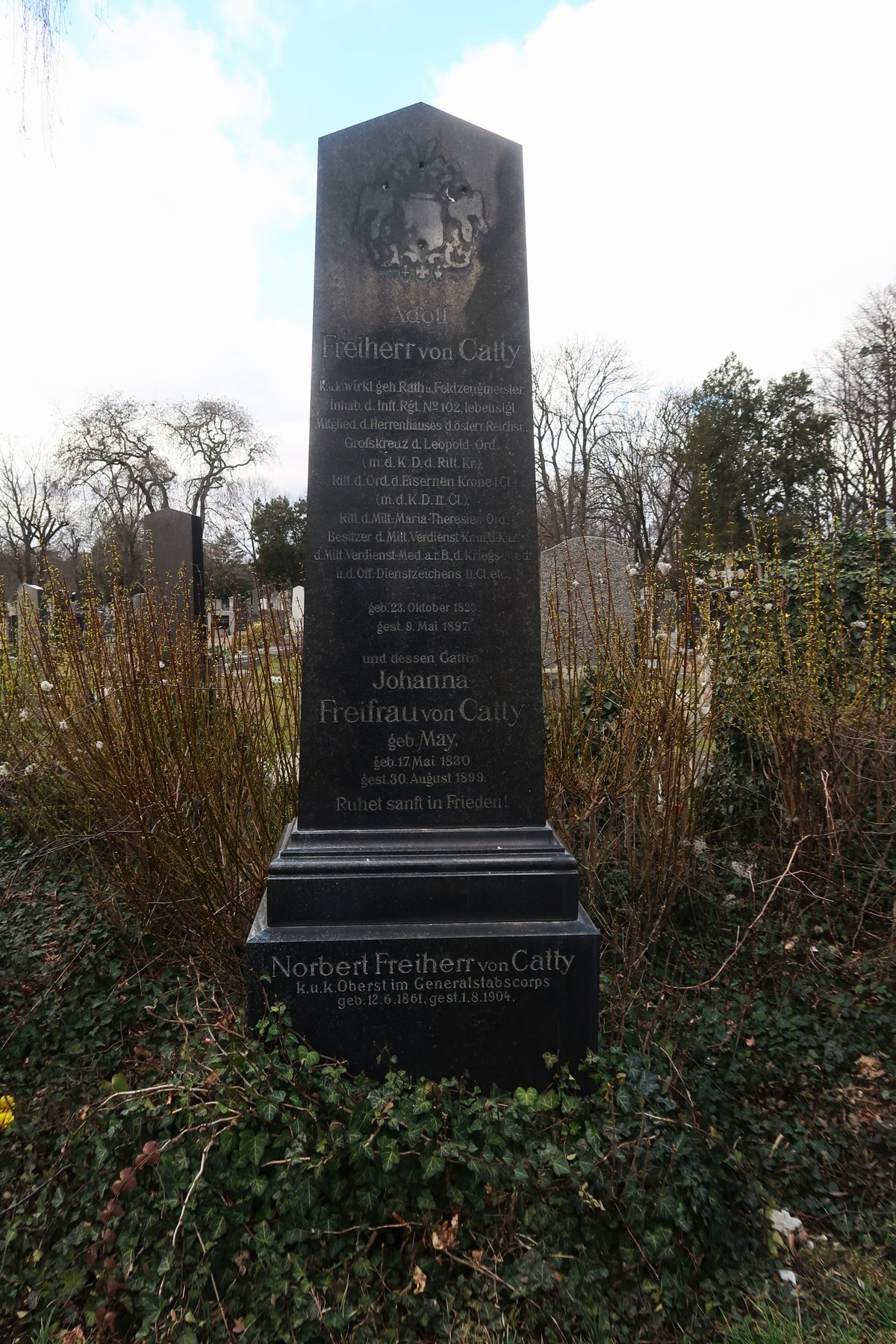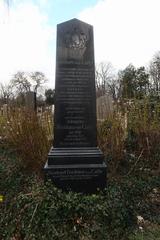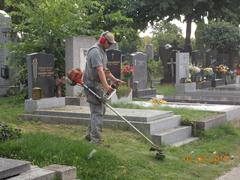
Vienna Central Cemetery: Visiting Hours, Tickets, Accessibility, and Guide to Vienna’s Historic Landmark
Date: 14/06/2025
Introduction
The Vienna Central Cemetery (Wiener Zentralfriedhof) is one of Europe’s largest and most culturally significant cemeteries. Established in 1874 to serve a rapidly expanding city and its diverse population, it now stands as both a monumental resting place—home to over three million interments—and a vibrant cultural landmark. The cemetery’s interdenominational character, architectural marvels, and concentration of Austria’s luminaries make it an essential destination for visitors interested in Vienna’s history, art, and multicultural legacy (vienna4u.at; SpottingHistory).
This comprehensive guide covers the cemetery’s origins, multicultural sections, honorary graves, architectural highlights, accessibility, visiting tips, and environmental initiatives. Whether you are a history buff, architecture enthusiast, or seeking a tranquil retreat, the Vienna Central Cemetery offers a unique and enriching experience.
Table of Contents
Origins and Historical Development
Vienna’s Central Cemetery opened on All Saints’ Day in 1874, developed in response to the city’s rapid growth and the necessity for a new, expansive burial ground. Located in Simmering, southeast Vienna, it was designed in the spirit of 19th-century park cemeteries, with broad avenues and landscaped grounds. The site quickly grew to accommodate Vienna’s diverse population, surpassing the city’s living population in interments (vienna4u.at; fotoeins.com).
Multicultural and Interdenominational Character
The Zentralfriedhof was conceived as an interdenominational cemetery—an innovation for its time. It contains dedicated areas for Catholic, Protestant, Orthodox Christian, Jewish, Muslim, Buddhist, Mormon, and other religious communities, reflecting Vienna’s multicultural evolution (vienna4u.at; allaboutvienna.com).
Catholic, Protestant, and Orthodox Sections
The largest section serves Vienna’s Catholic majority. Protestant and Orthodox sections, including Russian, Romanian, Greek, and Coptic communities, are distinct and easily located near various gates (fotoeins.com).
Jewish Cemeteries
Two significant Jewish cemeteries, the Old Jewish Cemetery (Gate 1) and the New Jewish Cemetery (Gate 4), preserve the heritage of Vienna’s Jewish community. They are maintained by the Israelitische Kultusgemeinde Wien (jewishinvienna.com).
Muslim, Buddhist, and Other Faiths
Reflecting changing demographics, the Zentralfriedhof includes sections for Muslims, Buddhists (the first Buddhist cemetery in Europe), and Mormons, underlining its inclusive, interfaith character (vienna4u.at).
Honorary Graves and Cultural Icons
The cemetery is renowned for its Ehrengräber (Graves of Honour), commemorating Austria’s most influential figures in music, literature, science, and politics. The Musicians’ Corner (Group 32A) is a pilgrimage site for music lovers, housing the graves of Beethoven, Schubert, Strauss, Brahms, and Schoenberg. A cenotaph for Mozart stands among them (vienna4u.at; Visiting Vienna; Wikipedia).
Other notable interments include painter Hans Makart, sculptor Caspar von Zumbusch, writer Arthur Schnitzler, and the pop star Falco. The cemetery also contains the graves of Austrian presidents, scientists like Ludwig Boltzmann, and other modern icons. Maps and signage at the main entrance (Tor 2) help visitors locate these graves (Visiting Vienna).
Architectural and Artistic Heritage
At the cemetery’s heart stands the Karl-Borromäus-Kirche (St. Charles Borromeo Church), a masterpiece of Viennese Art Nouveau (Jugendstil) by Max Hegele, completed in 1911. Its monumental dome, elegant façade, and richly decorated interior blend tradition with modernism and serve as a venue for cultural events. The cemetery is also a showcase of funerary art, from elaborate mausoleums and allegorical sculptures to unique gravestones in Jewish, Orthodox, and Muslim sections (SpottingHistory; fotoeins.com).
The Cemetery in Vienna’s Social Fabric
Zentralfriedhof is more than a burial ground; it reflects Vienna’s social history and democratic ethos, interring both celebrated and ordinary citizens. Its tranquil, park-like setting is a sanctuary for wildlife—deer, squirrels, rare birds—and a welcoming green space for the city (vienna-unwrapped.com; fotoeins.com).
Visitor Experience and Practical Information
Visiting Hours
- General opening: Daily from 7:00 AM to sunset (typically 7:00 PM in summer; hours may vary seasonally).
- Special hours: Extended on Thursdays between May and August.
- Karl-Borromäus-Kirche: May have separate hours, especially during events (Wien Info).
Tickets and Admission
- Cemetery entry: Free of charge.
- Guided tours and events: May require tickets (guided tours around €35 per person; check official sites for current prices and booking) (secretvienna.org).
Getting There
- Public transport:
- Tram 71 or 11: Stop at “Zentralfriedhof 2. Tor” (main entrance).
- Tram 71: Also serves “Zentralfriedhof 1. Tor” (Old Jewish Cemetery) and “4. Tor” (New Jewish Cemetery).
- Tram 18: Stops at “3. Tor” (Protestant section).
- By car: Parking available but public transport is recommended (vienna-unwrapped.com).
Accessibility
- Wheelchair access: Main entrances and paths are wheelchair accessible; some older sections may be uneven.
- Restrooms: Accessible facilities available near the main entrance.
- On-site mobility: Walking, bicycles, horse-drawn carriage, and bus tours available (visitingvienna.com).
Maps and Navigation
Free maps are available at the main gates and online (vienna4u.at). Information boards and signage help visitors locate notable graves and sections.
Etiquette
- Behave respectfully, especially near ongoing funerals and in religious sections.
- Dress appropriately; be mindful of customs in Jewish and Muslim areas.
- Photography permitted for personal use; be discreet, particularly during ceremonies.
Guided Tours and Events
- Guided tours: Offered in multiple languages, focusing on music, art, Jewish heritage, and cemetery secrets. Booking in advance is recommended.
- Cultural events: Concerts, exhibitions, and installations, especially in the Karl-Borromäus-Kirche, highlight the cemetery’s role as a vibrant cultural venue (allaboutvienna.com).
Photographic Highlights
Top spots include the Jugendstil church, Musicians’ Corner, honorary graves, and natural parkland. The grounds are especially atmospheric during All Saints’ Day and autumn.
Environmental Initiatives and Biodiversity
The Zentralfriedhof is a vital urban green space supporting rich biodiversity. Wildlife such as deer, foxes, and birds thrive among carefully maintained gardens and intentionally wild areas. Vienna’s environmental policies foster green corridors linking the cemetery to city parks, while citizen science projects invite visitors to help monitor local flora and fauna (imp.ac.at; anpedi.org). The cemetery’s management balances the preservation of historical monuments with ecological stewardship, enhancing both heritage and sustainability.
Frequently Asked Questions (FAQ)
Q: What are the Vienna Central Cemetery’s visiting hours?
A: Generally from 7:00 AM to sunset, with extended hours in summer and on certain days. Check the official website for seasonal updates.
Q: Is there an entrance fee?
A: Entrance to the cemetery is free. Tickets are required only for guided tours, carriage rides, or special events.
Q: How do I get there by public transport?
A: Tram lines 11 and 71 stop at the main gates; tram 71 also serves other entrances.
Q: Is the cemetery wheelchair accessible?
A: Yes, main entrances and primary paths are accessible, but some older areas may be uneven.
Q: Are guided tours available?
A: Yes, including themed public and private tours as well as horse-drawn carriage rides.
Q: Can I take photographs?
A: Yes, for personal use. Please be discreet and respect privacy during ceremonies.
Q: Are there facilities like restrooms and cafés?
A: Yes, restrooms and small cafés are near the entrance and at key points within the cemetery.
Conclusion
The Vienna Central Cemetery is more than a burial site—it is a living monument to Vienna’s historical depth, multicultural identity, and artistic legacy. Its open, accessible grounds invite visitors to walk through the city’s storied past, from imperial grandeur to contemporary diversity. With free admission, excellent public transport links, wheelchair-accessible paths, and a wealth of cultural and natural attractions, the Zentralfriedhof is a must-visit for anyone exploring Vienna’s historical sites.
Plan your visit by checking current opening hours and booking guided tours as needed. Download the Audiala app for curated audio tours and insider tips, and follow official channels for updates on cultural events and accessibility features.
Discover Vienna’s stories in stone—visit the Zentralfriedhof and experience one of Europe’s most remarkable historical landmarks.
References and Further Reading
- Vienna Central Cemetery: A Historical and Multicultural Marvel with Visitor Guide and Tips, 2024 (vienna4u.at)
- Vienna Central Cemetery: Visiting Hours, Tickets, and Cultural Highlights, 2024 (SpottingHistory)
- Visiting Vienna Central Cemetery: Honorary Graves, Visiting Hours, Tickets, and Historical Highlights, 2024 (Visiting Vienna)
- Vienna Central Cemetery: Visiting Hours, Tickets, and History of Vienna’s Historic Cemetery, 2024 (vienna-unwrapped.com)
- Beyond Death: The Vienna Central Cemetery as a Unique Cultural Venue, 2024 (allaboutvienna.com)
- The Secrets of the Central Cemetery Tour, 2024 (secretvienna.org)
- Enhancing Biodiversity at the Vienna Biocenter (imp.ac.at)
- Vienna’s Sustainability Efforts (anpedi.org)
Audiala2024

